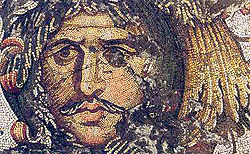
The Byzantine Great Palace of Constantinople, (Greek: Μέγα Παλάτιον, Turkish: Büyük Saray), also known as the Sacred Palace (Latin: sacrum palatium, Greek: Ιερόν Παλάτιον), was a large palace complex, located in the south-eastern end of the peninsula where the city lies. It served as main residence of the Byzantine emperors from 330 AD to 1081 AD and was the centre of imperial administration for approximately 800 years.
History
When Constantine I founded the city of Constantinople in 330, he planned out a palace for himself and his heirs. The palace was located between the Hippodrome and Hagia Sophia. It was rebuilt and expanded several times, especially under the emperors Justinian I and Theophilos.
Until the late 12th century, the Great Palace served as the primary administrative and ceremonial centre of the city, although from the early Comnenian era the palace of Blachernae was favoured as an imperial residence. During the sack of Constantinople by the Fourth Crusade, the Palace was plundered by the soldiers of Boniface of Montferrat. Although the subsequent Latin emperors continued to use the Palace complex, they lacked money for its maintenance. The last Latin emperor, Baldwin II, went as far as removing the lead roofs of the Palace and selling them.
Consequently, when the city was retaken by the forces of Michael VIII Palaeologus in 1261, the Great Palace was in a bad state. The Palaeologus emperors largely abandoned it, ruling from Blachernae, so that when Mehmed II entered the city in 1453, he discovered it to be ruined and abandoned. As he wandered its empty halls and pavilions, he allegedly whispered a quote from the Persian poet, Ferdowsi:
"The spider spins his web in the Palace of the Caesars,
An owl hoots in the towers of Afrasiyab."
Much of the palace was demolished in the general rebuilding of Constantinople in the early years of the Ottoman era. However, an early 20th century fire uncovered a section of the Great Palace. On this site prison cells, many large rooms, and possibly tombs were found. Contemporary excavations are continuing in Istanbul on the Great Palace. So far, less than one quarter of the total area covered by the palace has been excavated. Most of the unearthed mosaics have been housed in the Istanbul Mosaic Museum.
Description
The Palace was located in the southeastern corner of the peninsula where Constantinople is situated, behind the Hippodrome and the Hagia Sophia. The Palace is considered by scholars to have been a series of pavilions, much like the Ottoman-era Topkapı Palace that succeeded it. The total surface area of the Great Palace exceeded 20,000 square feet.
The main entrance to the Palace quarter was the Chalke Gate (Χαλκή Πύλη, the Bronze, literally "Copper", Gate, also translated as the "Brazen Door"), at the square of the Augustaeum. The Augustaeum was located on the south side of the Hagia Sophia, and it was there that the city's main street, the Mese ("Middle Street"), began. To the east of the square lay the Senate house or Palace of Magnaura, where the University was later housed, and to the west the Milion (the mile marker, from which all distances were measured), and the old Baths of Zeuxippos.
Immediately behind the Chalke Gate, facing southwards, were the barracks of the Palace Guards, the Scholae. After the barracks stood the reception hall of the 19 Accubita ("Nineteen Couches"), followed by the Palace of Daphne, in early Byzantine times the main imperial residence. It included the Octagon, the emperor's bedchamber. From the Daphne, a passage led directly to the imperial box (kathisma) in the Hippodrome. The main throne room was the Chrysotriklinos, built by Justin II, and expanded and renovated by Basil I. To its north lay the Trikonkhos palace, built by the emperor Theophilos and accessible through a semicircular antechamber known as the Sigma. To the east of the Trikonkhos lay the lavishly decorated Nea Ekklesia ("New Church"), built by Basil I, with five gilded domes. The church survived until after the Ottoman conquest. It was used as a gunpowder magazine and exploded when it was struck by a lightning in 1490. Between the church and the sea walls lay the polo field of the Tzykanisterion.
Further to the south, detached from the main complex lay the seaside palace of Bucoleon. It was built by Theophilos, incorporating parts of the sea walls, and used extensively until the 13th century. A seaward gate gave direct access to the imperial harbour of Bucoleon.

No comments:
Post a Comment